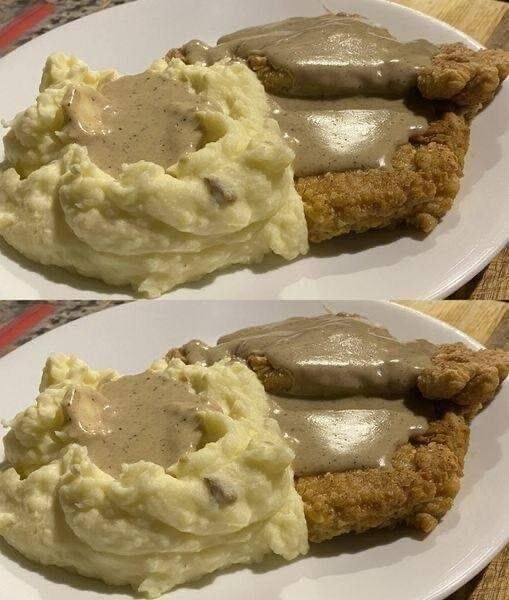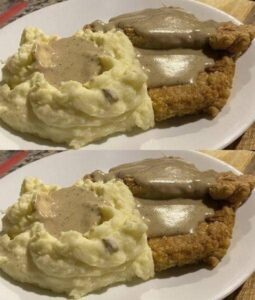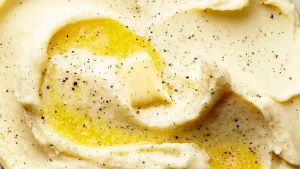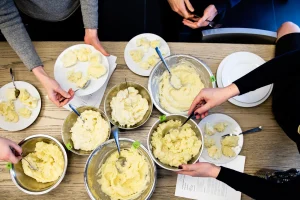The Mistake Everyone Makes with Mashed Potatoes

Creamy Mashed Potatoes (Serves 6–8) Why You’ll Love Them
Rich, buttery, and irresistibly smooth, these mashed potatoes are the perfect comfort food. Whether you’re hosting a holiday dinner or making a cozy weeknight meal, they’re easy to customize and always a crowd-pleaser.
Ingredients: 4 lbs Yukon Gold or Russet potatoes, peeled & cut into chunks, 1 cup warm heavy cream (or whole milk for lighter version), ½ cup unsalted butter, melted, 1 tsp salt, ½ tsp black pepper (or to taste), Optional mix-ins:roasted garlic, grated Parmesan, chopped chives, parsley, or a dollop of sour cream.

Instructions: Cook the Potatoes: Place potatoes in a large pot of salted water. Boil for 15–20 minutes, or until fork-tender. Drain & Dry: Drain well. Return potatoes to the warm pot for 1–2 minutes to let extra moisture evaporate.
Mash to Perfection: Mash until smooth (use a potato masher for rustic texture or a ricer for extra creamy). Gently stir in warm cream and melted butter. Season & Customize: Add salt and pepper to taste. Fold in any optional mix-ins. Serve & Enjoy: Transfer to a serving bowl. Top with a pat of butter or a sprinkle of fresh herbs.
Tips for the Creamiest Potatoes: Always use warm cream or milk — cold dairy can make potatoes stiff. Don’t overmix, or they may turn gluey. Store leftovers up to 3 days in the fridge. Reheat gently with a splash of cream.
Delicious Variations:
- Roasted Garlic Mash: Mix in 2–3 roasted garlic cloves for a rich flavor.
- Cheesy Mash: Stir in Parmesan, cheddar, or cream cheese. Herb Lovers’ Mash: Add fresh chives, parsley, or dill.
- Tangy Mash: Fold in a spoonful of sour cream for extra creaminess.
These mashed potatoes pair perfectly with fried chicken, beef roast, or your favorite gravy — just like in the photo above!
6 Secrets To the Best Mashed Potatoes Ever

One potato to rule them all.
First things first: we had to start with the potatoes. Epi has recipes using russets, Yukon Golds, red-skinned spuds, and many other types of potatoes (but we all know it’s between the russets and the YuGs, right?). While russets have a pure, baked potato-y flavor and fluffy texture, our blind taste test revealed that four out of five staffers preferred the creamy texture and buttery goodness of Yukon Golds.
Cook them with care.
Most recipes will tell you to start your potatoes in cold, salty water, which is great advice! Starting in cold (and cutting them in similar-sized chunks) helps the potatoes to cook more evenly, rather than shocking the exteriors and cooking them to crumbles while leaving the interiors underdone. Simmer them at a moderate pace—hard-boiled potatoes can become waterlogged. And whatever you do, don’t skip the step we learned from Light and Silky Mashed Potatoes: Drain the potatoes and return them to the pot and cook, shaking, for 1–2 minutes until all the excess moisture has evaporated. Your resulting spuds will be creamy, not watery. And, just to be extra thorough, we tried baking our potatoes, too, like in Earthy Mashed Potatoes. While you don’t have to worry about a diluted potato flavor, cooking potatoes takes longer this way, and it’s difficult to quickly remove the skins and mash them while still hot.
Rice, rice baby.
Once we established our potato of choice, we moved on to mashing technique. We tasted recipes side by side that had been mashed using a traditional masher (good but a little lumpy; fine for those who prefer a more rustic mash), ricer (smooth as silk), food mill (pretty similar to the ricer), stand mixer with paddle attachment (a decent substitute if you don’t have a ricer or food mill and are making a large quantity, but a little gluey for our tastes), and a food processor (NOPE: Gummytown, USA). The moral of the story? The best mashed potatoes aren’t mashed at all, instead they are pressed using a potato ricer, which pushes them through a grid of small holes (kind of like a garlic press), breaking them into tiny pieces and keeping them light and fluffy without overworking them. The more potatoes are mashed or mixed, the gluier they become, which is why the spuds puréed in a food processor were such a mess. We don’t often recommend unitasker tools, but this is an exception. For the smoothest, most velvety mashed potatoes, invest in a potato ricer.

Creaminess is next to godliness.
Another big question: what to add to make the potatoes rich and creamy? We tried recipes with butter and milk of course, but also added heavy cream (super rich and a little too decadent), buttermilk (tangy but a little watery), cream cheese (added a little too much body and heaviness), and even a dairy-free version with olive oil (spoiler alert: mashed potatoes taste better with dairy!). The butter + milk combo was hard to beat, but we felt it needed a little something extra. That’s when we took a cue from these Sour Cream Mashed Potatoes and folded in a small amount of sour cream as well. That gave our potatoes the perfect amount of buttery creaminess with just a touch of tang.
Add a little something extra.
Our mashers were almost done—we just wanted to build a little more background flavor. We loved the herb infusion in these Extra Buttery Mashed Spuds and decided to infuse our milk with thyme sprigs. We were also crazy for cooking the potatoes with garlic cloves, then pressing them through the ricer along with the spuds, as in this recipe for Perfect Mashed Potatoes. Raw garlic can be overwhelming, but adding softened, cooked garlic cloves to the ricer with the potatoes breaks them into tiny pieces that permeate the potatoes with subtle garlic flavor.
Yes, you can make them ahead.
Mashed potatoes are best eaten right away, but sometimes large gatherings like Thanksgiving make dinner choreography challenging. You can always do the prep ahead: peel and cube the potatoes and store submerged in water in the fridge up to 24 hours in advance. Or, go ahead and make your mash, but reserve 1/2 cup of the milk and butter mixture. Cover and store at room temperature up to two hours, or chill, covered, up to 8 hours. Reheat over medium and gently fold in the reserved liquid.
